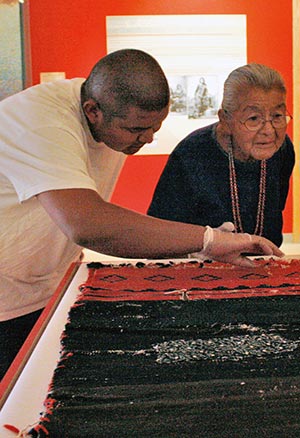Wooshdéé', biil!
Juanita's descendants welcome home her weavings
By Cindy Yurth
Tséyi' Bureau
WINDOW ROCK, Sept. 2, 2010

(Special to the Times - Stacy Thacker)
Rose Nez, the great-great granddaughter of Juanita Manuelito, wife of Chief Manuelito, and her grandson Nicholas Denetdale, take a closer look at Juanita's dress during its unveiling at the Navajo Nation Museum in Window Rock.
The dress and saddle blanket woven by Juanita, who died in 1910, were carefully lifted out of their cardboard boxes, unfolded and put on display as part of the Chief Manuelito exhibit, which opened Aug. 27.
But not until several pairs of eager hands in latex gloves fondled them for a while.
Seeing and touching the weavings was an emotional experience for Juanita's great-great-granddaughter, great-great-great-granddaughters and great-great-great-great grandson.
"To me, I can see her," said Rose Nez, 76, of Tohatchi, N.M., Juanita and Manuelito's great-great-granddaughter. "I think she's watching us. That's the way I feel. She must be proud and smiling at us. Both of them."
Nez' daughter Jenny Nez, 57, said the family was aware they had famous ancestors, but didn't think much about it until her sister, historian Jennifer Nez Denetdale, wrote her book "Reclaiming Diné History: The Legacy of Chief Manuelito and Juanita."
"We all went, 'Whoa,'" Jenny Nez recalled. "That's when we knew we descended from somebody really special."
Denetdale's son Nicholas, 30, a welder and college student, also made the trip from Tohatchi to watch the dress being unpacked for its first time on exhibit in many years, if ever.
"That this thing just got taken, and for it to come home now, it makes me feel stronger and more powerful," he said. "It lifts my spirits to think that something you do, something you leave behind, can reach back years later and help someone."
Juanita gave the biil to her friend, photographer and collector George Wharton James, in 1874. It was already well worn and patched in several places with calico, and it is believed to have been woven between 1868 and the year he received it.
James lost the dress for a while, then found it, and it was eventually donated to the Southwest Museum in Los Angeles, now the Autry National Center. The items were archived, but it is not known if they were ever displayed. In her book, Denetdale writes of traveling to the museum in 1997 to see the weavings.
The simple dress and the somewhat newer saddle blanket, with a colorful star design in the center, arrived at the museum last week by climate-controlled truck, along with a conservator from the Autry Center, Angie McGrew.
Good curation demanded the weavings sit in their boxes for a length of time.
"I guess I didn't realize how important it was until I arrived about midnight on Tuesday and Jennifer and (museum exhibit curator) Clarenda (Begay) were there to greet it," said McGrew, who is Chiricahua Apache. "It's a wonderful artifact, but it didn't hit me until then how personal it is to the Navajo people."
McGrew said she is "so impressed" with the Manuelito exhibit.
"I feel confident about leaving these objects here for six months," she said.
Denetdale said other museums, including the visitor center at Bosque Redondo, have already expressed interest in hosting the exhibit after it is finished at the Navajo Nation Museum.
"It shows how important it is to be in a position to share our stories the way we want them told," she commented.

